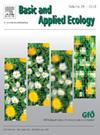Artificial light at night reduces larval survival and constrains female body mass in a capital breeding moth
IF 3.5
2区 环境科学与生态学
Q2 ECOLOGY
引用次数: 0
Abstract
Light pollution, caused by artificial light at night (ALAN), affects an ever-increasing area of the Earth and evidence is piling up on its negative effects on organisms, including insects. Besides direct sensory and physiological effects on adult behaviour, ALAN may also affect larval growth and developmental life cycle regulation (e.g., diapause induction). Moth species whose larvae are mainly diurnal may also be sensitive to the disruption of the day-night cycle by ALAN, but species with such an ecological profile remained understudied so far. The garden tiger moth Arctia caja mainly shows diurnal activity at the larval stages and adults are capital breeders that do not feed at all. In a split-brood rearing experiment, caterpillars of the F1 and F2 generation from wild-caught females were individually grown under either ALAN or control-dark conditions. We tested for constraints of ALAN on larval survival and development, and the consequences for body mass. We showed evidence for increased larval mortality under ALAN conditions in both the F1 and F2 generation. ALAN caused accelerated larval development by disturbing the induction of a feeding arrest (i.e., larval diapause). Pupal mass was lower under ALAN conditions, but only so in females. Capital breeders like A. caja are expected to be particularly affected by a decrease in female body mass since this will negatively affect fecundity and adult lifespan. Therefore, our results suggest that long-term exposure of moth populations to ALAN negatively affects capital breeding performance and hence population performance.
夜间的人造光降低了幼虫的存活率,并限制了雌蛾的体重
由夜间人造光(ALAN)引起的光污染,影响着地球上越来越多的区域,而且越来越多的证据表明,它对包括昆虫在内的生物产生了负面影响。除了对成虫行为的直接感觉和生理影响外,ALAN还可能影响幼虫的生长和发育生命周期调节(如诱导滞育)。以昼夜活动为主的蛾类幼虫可能对ALAN对昼夜循环的破坏也很敏感,但迄今为止对具有这种生态特征的物种的研究还不够充分。园虎蛾幼虫期以日间活动为主,成虫为资本繁殖者,完全不采食。在一项分卵饲养实验中,将野生雌性捕获的F1代和F2代幼虫分别生长在ALAN或对照黑暗条件下。我们测试了ALAN对幼虫生存和发育的限制,以及对体重的影响。我们发现,在ALAN条件下,F1和F2代的幼虫死亡率都有所增加。ALAN通过干扰摄食阻滞(即幼虫滞育)的诱导而加速了幼虫的发育。ALAN条件下蛹质量较低,但仅在雌性中如此。像caja这样的资本育种者预计会受到雌性体重减少的特别影响,因为这将对繁殖力和成年寿命产生负面影响。因此,我们的研究结果表明,长期暴露于ALAN的飞蛾种群会对资本繁殖性能产生负面影响,从而影响种群性能。
本文章由计算机程序翻译,如有差异,请以英文原文为准。
求助全文
约1分钟内获得全文
求助全文
来源期刊

Basic and Applied Ecology
环境科学-生态学
CiteScore
6.90
自引率
5.30%
发文量
103
审稿时长
10.6 weeks
期刊介绍:
Basic and Applied Ecology provides a forum in which significant advances and ideas can be rapidly communicated to a wide audience. Basic and Applied Ecology publishes original contributions, perspectives and reviews from all areas of basic and applied ecology. Ecologists from all countries are invited to publish ecological research of international interest in its pages. There is no bias with regard to taxon or geographical area.
 求助内容:
求助内容: 应助结果提醒方式:
应助结果提醒方式:


